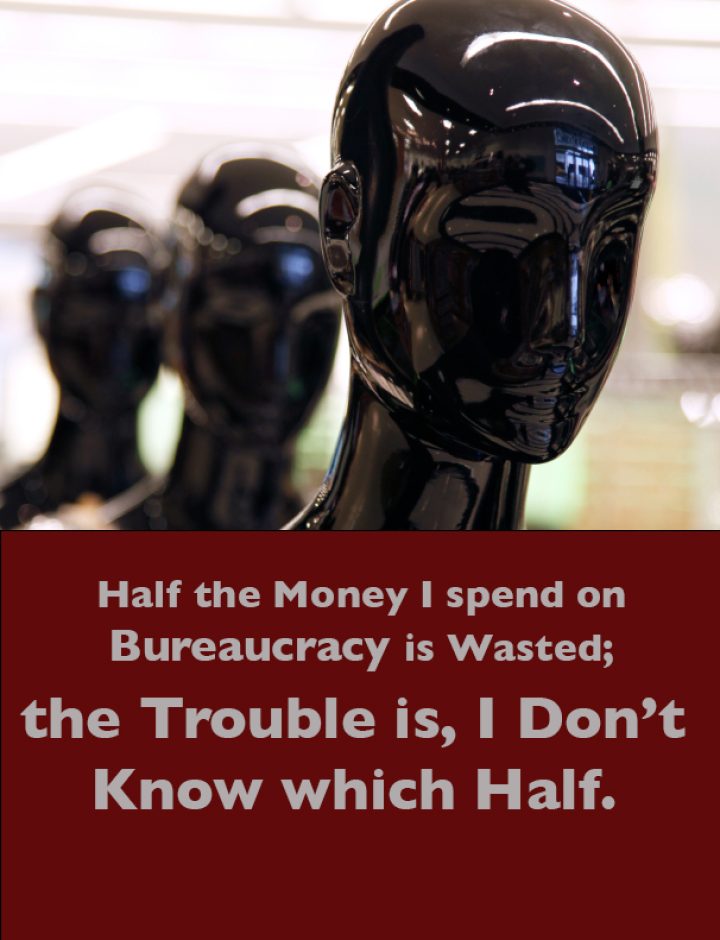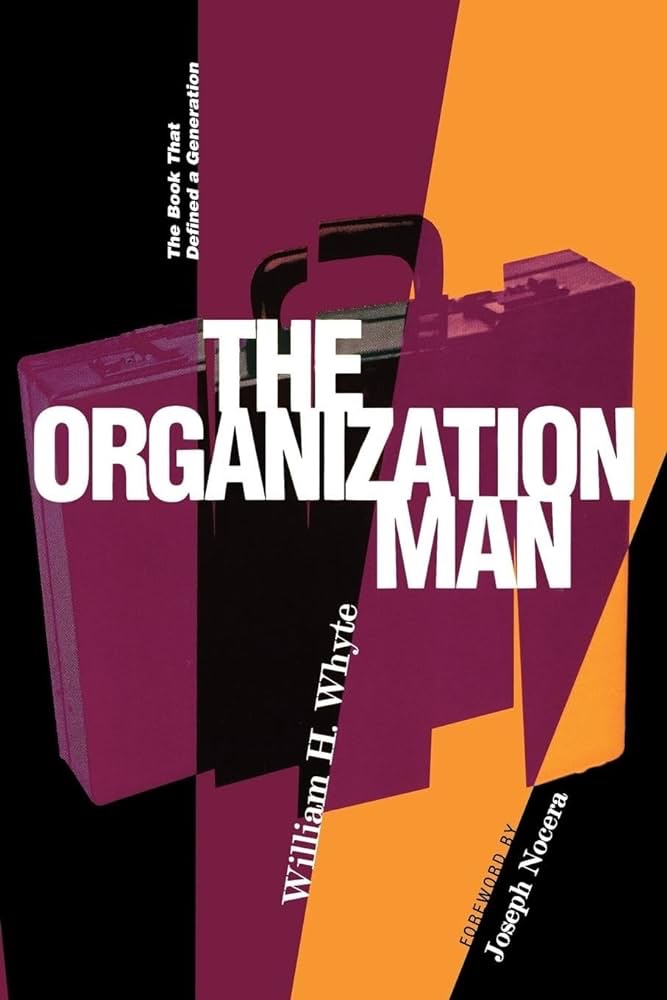
Half the money I spend on bureaucracy is wasted; the trouble is I don’t know which half.

Apologies to John Wanamaker for stealing this quote and applying it to bureaucracy rather than advertising. Yet there’s no better way to summarize the challenge of bureaucracy in today’s corporate world.
The New York Times recently published “Death by a Thousand Papercuts” — an excellent column about modern bureaucracy by columnist David Brooks. In that column Brooks looks at the “growing bureaucratization of American life” noting that the result will “redistribute power from workers to rule makers, and in so doing sap initiative, discretion, creativity and drive.”
Brooks notes the extraordinary economic costs of bureaucracy in America.
- Within healthcare alone expert David Himmelstein thought that in 2020, “The average American is paying more than $2,000 a year for useless bureaucracy.”
- And across the economy, “growth of bureaucracy costs America over $3 trillion in lost economic output every year, Gary Hamel and Michele Zanini estimated in 2016 in The Harvard Business Review. That was about 17 percent of G.D.P.”
He also offers a useful hint around the connection between bureaucratic growth and Trump’s dedicated MAGA followers. Listen with an open mind and I find, within MAGA screeds, conspiracy theories, and screams for attention, a constant theme about those who lose out within heavily bureaucratized America. In truth, this bureaucratization demands a narrowly defined type of individual and loses to society a tremendous amount of human value when individuals cannot thrive within its narrowness.
Let me also note that growth in government is not tied to party. Certainly liberals in the US have a reputation for building new bureaucracies. Bureaucratic creep, though, is driven by all politicians through legislation. Every time a legislator gets a new rule passed — perhaps a conservative wanting to eliminate certain books from school libraries — they expand the bureaucracy by adding more bureaucrats and more paperwork. Locally, when our Oregon legislature passed a law mandating that “all high school graduates be taught CPR” they forced the district to build a new bureaucratic program to comply with the law. The programs relied on existing teaching staff but required more bureaucracy.
Government bureaucracy, though, isn’t my primary concern. Bureaucracy in business is where things are tremendously out of control. Narrow bureaucracies have taken over many corporate cultures. Preferring rules to effectiveness, this bureaucracy created today’s micro-management by metric and has shifted career success in a company to success in bureaucratic politics — not achievement.
Yet it is Nothing New — Consider The Organization Man from 1956
Brooks partly suggests this bureaucracy is the result of companies building structures of safety within the current climate of regulation. This has truth but also follows an ideological tendency to blame government for bureaucracy. In reality, corporate bureaucracy thrives for far different reasons. In part, it has been built by executives hoping to turn the unpredictable challenge of doing business into a fully predictable discipline. MBA programs aid and abet this approach given the many ways in which an MBA degree is a study of management through bureaucracy.
 This is also not new. In 1956 William Whyte published the Organization Man — a sociological study of corporations which includes three chapters focused on the “Fight Against Genius.” His observations apply today starting with genius:
This is also not new. In 1956 William Whyte published the Organization Man — a sociological study of corporations which includes three chapters focused on the “Fight Against Genius.” His observations apply today starting with genius:
Customarily, whenever the word brilliant is used, it either precedes the word but (cf. “We are all for brilliance, but …”) or is coupled with such words as erratic, eccentric, introvert, screwball, etc. To quote Mr. Steele again, “While industry does not ignore the brilliant but erratic genius, in general it prefers its men [and women] to have ‘normal’ personalities.” (p212)
And also this on genius:
If [administrators] get scientists to be good company men like other normal people, they won’t be bothered much by scientists’ following their curiosity. The policy will keep out that kind of scientist. For what is the dominant characteristic of the outstanding scientist? Every study has shown that it is a fierce independence. (p211)
That’s only a start. Here’s a more concerning truth (we still see today) about hiring practices:
If the criteria set up by many personnel men were to be applied across the board, the majority of US corporation executives would be out of a job tomorrow. (p141)
And, finally, corporate inability to comprehend the people who do what matters most:
[T]his the administrator cannot conceive…that a man [or woman] can dislike the company…and still have made a net contribution to the company cash register infinitely greater than all of his better-adjusted colleagues put together. (p141)
The Bureaucratic Truth — We Will Never Know Which Half is Wasted
While bureaucracies today impose metric based plans claiming to measure the effectiveness of individuals and departments then dispense rewards or punishment based on those metrics, bureaucracies are never evaluated in a way which matters by answering the critical questions:
Do they matter to the company?
Do they contribute to the cash register?
Is the company more successful for their existence?
Unfortunately, we simply cannot answer these questions until it’s too late — until the existence of the bureaucracy has weakened a company to the point of collapse. Consider some truths:
- Bureaucracies only build AFTER companies have their initial success. As a result, they are built based on the company already succeeding in the market and are built from overhead funds based on the profits flowing into the company.
- Thus, no bureaucracy has ever had to justify its existence based on mattering to the bottom line.
- Bureaucracies are judged successful by making managers and executives happy — not because they matter.
- No bureaucracy will ever recommend its own demise.
- Bureaucracies always grow and never shrink.
- Hired gun CEOs (and other executives) are products of bureaucracy and tend to remain blind to the problems in bureaucratic management.
Within this, the digital revolution shares blame. Claimed to “increase productivity,” the presence of computers and connected devices today allows bureaucracy to invade every corner of a company to measure any obscure bit of data some bureaucrat wants. There are companies where keystrokes are counted by centralized software. All this is measured without anyone stopping to ask “does it matter?”
Still, around half (or so) of the bureaucracy is useful. Some matters a great deal and is exceptionally critical to success. Consider Investopedia’s definition:
The term bureaucracy refers to a complex organization that has multilayered systems and processes. The systems and processes that are put in place effectively make decision-making slow. They are designed to maintain uniformity and control within the organization.
When uniformity and control are critical to success or when slowing decision making is a good idea, bureaucracy is very important.
Yet the other half of the bureaucracy becomes an array of power centers delivering nothing of significance to the company — like those ever-expanding bureaucracies of “quality control.” Wise individuals know that separate quality control bureaucracies fail to ensure quality control. As W. Edwards Deming observed quality problems are most often a result of the system — not oversight of individuals. Perhaps we should make Boeing’s 8,000 employee quality team on the 737 MAX program our poster child for the quality bureaucracy error for its near catastrophe failures on those airplanes.
The Absolute Bureaucratic Truth
Regardless, we must begin to accept the ultimate truth about the bureaucratic:
Half the money I spend on bureaucracy is wasted; the trouble is I don’t know which half.
It’s time to begin figuring it out. How? I’ve learned a great deal about Theory of Change from my good friend Michael Bamberger who is deeply involved with evaluating development programs and ran such programs for the World Bank. He writes about Theory of Change in some of his books on evaluating development efforts — books drawing on insight from complexity science. Most critically, Theory of Change requires that we articulate assumptions, hypothesis, action and process, and metrics — as well as take time to evaluate a “whole outcome” to see whether change really did occur.
Despite the massive arrays of measured goals in corporate programs, those same programs don’t investigate whether improving measures actually makes a difference. Despite the complexity of our world, most corporate metric programs evaluate only whether focusing on metric X leads X to improve. Of course, once metrics are a focus they always improve. But their improvement is often entirely disconnected from company success.
It’s time for out of control bureaucratic growth to cease. It will…if we seriously evaluate whether the programs matter.
Until next time… Peace and be well.
©2024 Doug Garnett — All Rights Reserved
Through my company, Protonik LLC, I consult with companies as they design and bring to market new and innovative products. I am writing a book exploring the value of complexity science for driving business success. Protonik also produces marketing materials including documentaries, websites, and blogs. As an adjunct instructor at Portland State University I teach marketing, consumer behavior, and advertising.
You can read more about these services and my unusual background (math, aerospace, supercomputers, consumer goods & national TV ads) at www.Protonik.net.
Categories: Business and Strategy
